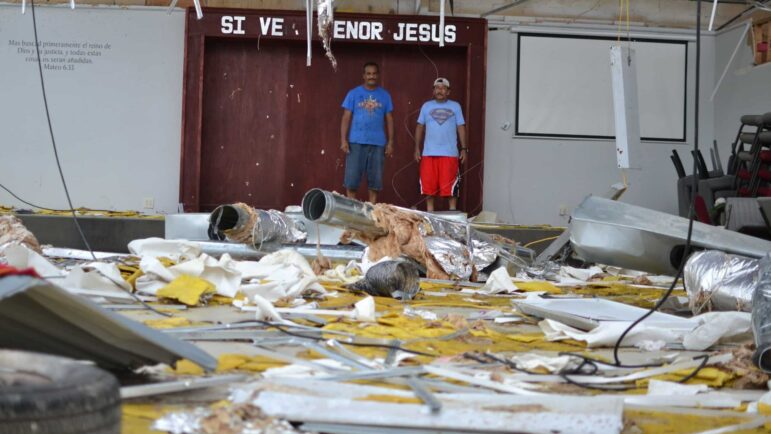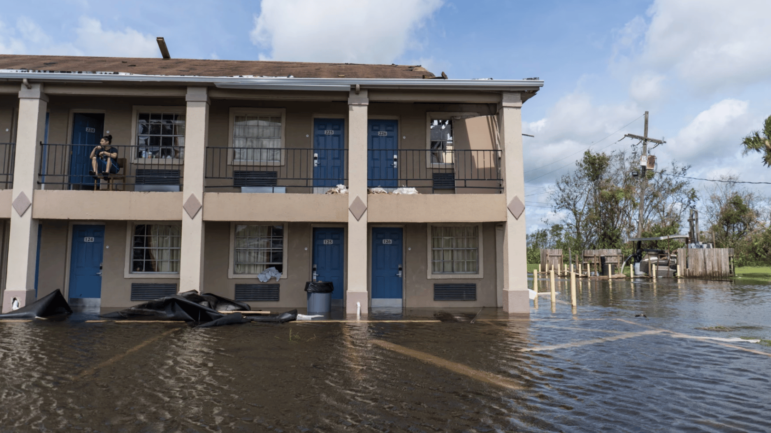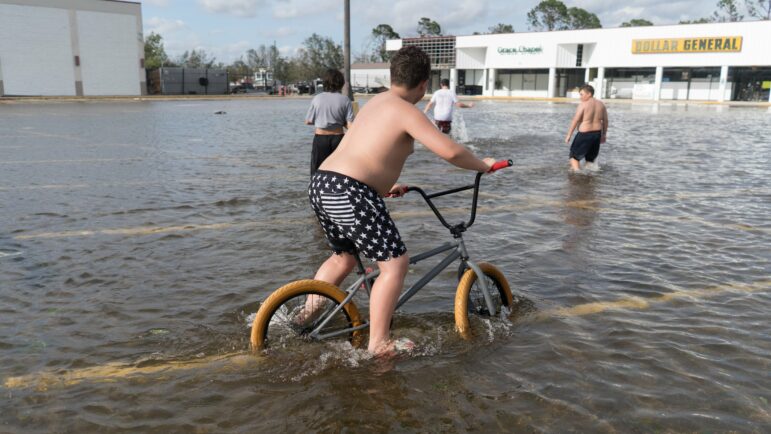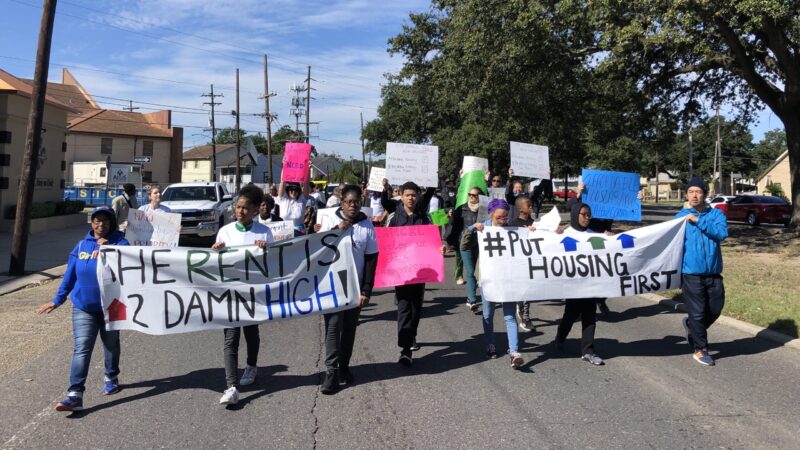Gulf States rank at the bottom for climate-adapted housing. Organizers want to change that.
Members of the housing advocacy group Housing Louisiana say that climate change is making already poor housing conditions worse. They hope a new scorecard can encourage policymakers to act faster.
It’s been over two years since the home Cynthia Thomas shared with her mother was destroyed, and the main thing that sticks with her is how fast it all happened.
When an EF-3 tornado touched down in Monroe, Louisiana in April 2020, Thomas said she had only seconds to find shelter for her and her three children. They hid in her mother’s closet, and even emergency responders were surprised to see that they survived.
“Everybody was like, ‘How did you manage to get out of there?’ Because the home was completely destroyed,” Thomas said. “[There] was no roof, our car was in the home and it was tragic.”
To make matters worse, Thomas said she barely received any housing assistance during the three months her family was put out of their home. She received nothing from the city of Monroe, the Federal Emergency Management Agency or the Louisiana Housing Corporation. Only the American Red Cross of Northeast Louisiana gave her a $500 stipend for property damage and two weeks to stay in a hotel.
Those two weeks ended fast, though, and Thomas and her family needed to find permanent housing quickly. But just when she thought she found more stable housing, she discovered the area she almost relocated to was flood-prone.
“That same area that they were going to relocate us in flooded and some roofs were caving in. So those people had to also relocate to a hotel for two weeks,” Thomas said.
Thomas and her family were able to stay with an aunt and eventually found permanent housing three months after the tornado.
As natural disasters and unpredictable weather in the Southeast become more frequent due to climate change, stories like Thomas’ are becoming more common. A new scorecard wants to measure how prepared states are to deal with it and give tips for how they can improve.
Gulf South ranks low on scorecard

Today, Thomas is a program coordinator at Housing Louisiana where she assists people who find themselves in the similar situation she did two years earlier. She said one of the most rewarding parts of her job is empowering other Louisianians to hold policymakers accountable.
“Something that I learned since starting here is basically, you know, finding a way to find your voice as it relates to your well-being,” Thomas said. “You have to fight for it because sometimes no one else is gonna fight for you.”
The information in The American Council for an Energy-Efficient Economy’s (ACEEE) “Pathways to Healthy, Affordable, Decarbonized Housing: A State Scorecard” report, released last month, could be a useful tool in that fight. Sara Hayes, the lead author of the report and the director of health and environment at ACEEE, said the scorecard is the first of its kind.
“[The scorecard]ranks all the states and the District of Columbia to evaluate the approach states are taking to providing healthy, affordable, and decarbonized or clean energy housing,” Hayes said.
In the past, factors like affordable housing and health were looked at separately, but the COVID-19 pandemic made ACEEE realize they needed to take a more holistic approach, she said.
The scorecard looks at five categories such as energy, utilities and affordable housing that are worth 20 points each for a total possible score of 100 points. Maryland received the top ranking with a score of 55 points. The Gulf South states all ranked in the bottom 10 — Alabama at 45 with 9.5 points, Louisiana at 47 with 8.5 points and Mississippi at 50 with 6.5 points. Only North Dakota — which scored 1.5 points — ranked below Mississippi.
Common housing issues in our states

Andreanecia Morris, president and chair of the Greater New Orleans Housing Alliance, said she wasn’t surprised by the results.
“Louisiana's Louisiana-ness is why we're in the bottom 10 and it is that failure to address needs from a systemic standpoint that's the bigger problem,” Morris said.
Common housing issues amongst people that Morris’ organization assists include high utility bills, living in flood-prone areas, and the lack of access to many other resources people can take for granted.
“Not everybody has running water. Not everybody has a roof that doesn't leak. Not everyone has their own bedroom for every member of the home,” Morris said.
The ACEEE report describes a healthy home as one that is “clean, safe, well ventilated, and free of pests and contaminants.” However, according to the report, Black, Indigenous and other communities of color have historically been denied access to healthy housing.
The report also mentions that these communities “already suffer higher rates of health harms — including asthma, heart attack, stroke, and high blood pressure — compared to white communities, and poor housing conditions worsen these health harms.”
Morris said it's disheartening when policymakers don’t seize on opportunities that can benefit their constituents. She points to the more than $30 million in relief funds South Louisiana received for hurricanes Katrina, Laura and Ida in May that are allocated but still sitting.
A ‘hopeful document’ for change

Although Louisiana and the other Gulf States aren't ranked higher on ACEEE’s scorecard, Morris views the report as a “hopeful document” that can serve as a roadmap for future improvements.
According to the ACEEE report, many states haven’t taken advantage of opportunities that would benefit the people there. The report argues that many housing or energy efficiency policies that already exist in high-ranking states could be expanded nationwide.
For example, the report suggests that it should become a common practice for states to specify “health requirements in new construction guidelines for affordable housing.” The organization also suggests that state agencies develop methods for cross-agency data sharing.
Morris also believes the report can help policymakers see what to prioritize, so they can make fewer excuses on why change isn’t happening fast enough.
“We've got achievable goals, even if we're miles away, we know where we're going,” Morris said.
As the lead author of the ACEEE report, Hayes acknowledges that these kinds of rankings can feel unfair to states in the Southeast as they are constantly contrasted with states with bigger populations in the Northeast or West. But Hayes says that population or size does not dictate a state’s outcome.
She points out that a state as big as California and a state as small as Rhode Island both ranked in the top three on the scorecard despite being on opposite ends of the coast and having opposite sizes of populations, and opposite amounts of resources.
“It’s not about geography. It’s not about the size of population,” Hayes said. “There is nothing holding the Southeast states back, I just want to make that really clear.”
This story was produced by the Gulf States Newsroom, a collaboration among Mississippi Public Broadcasting, WBHM in Alabama and WWNO and WRKF in Louisiana and NPR.
Top Instagram reels from Goats and Soda in 2025: Plumpy’Nut, aid cuts, soccer grannies
Our most-viewed Instagram videos include reports from a Rhode Island factory that makes special food for malnourished children and from a tournament for soccer-playing "grannies."
‘The Rest of Our Lives’ takes readers on a midlife crisis road trip
America's literary highways may be plenty crowded with middle-aged runaways fleeing lives that increasingly feel like a bad fit. But Ben Markovits adds a moving tale to the collection.
Hunker down with these 13 mysteries and thrillers from 2025
Mysteries and thrillers are enjoyable no matter the season, but there's something extra satisfying about curling up in the winter with a warm drink and an all-engrossing read. Here's what we suggest.
Should the U.S. model its vaccine policy on Denmark’s? Experts say we’re nothing alike
The Trump administration wants to revamp U.S. childhood vaccination recommendations to align with some other peer nations, including one tiny country in northern Europe.
Marijuana rescheduling would bring some immediate changes, but others will take time
President Trump set the process in motion to ease federal restrictions on marijuana. But his order doesn't automatically revoke laws targeting marijuana, which remains illegal to transport over state lines.
The cultural works becoming public domain in 2026, from Betty Boop to Nancy Drew
The original Betty Boop, the first four Nancy Drew books and Greta Garbo's first talkie are among the many works from 1930 that will be free to use, share and remake starting on Jan. 1.








